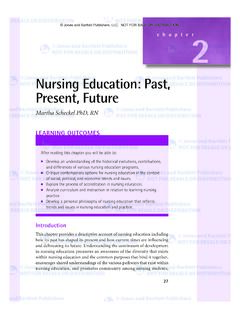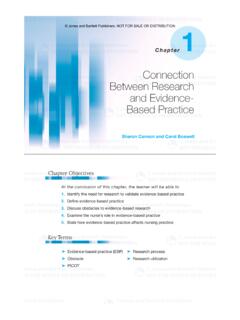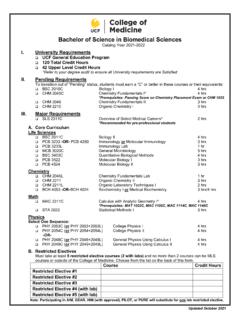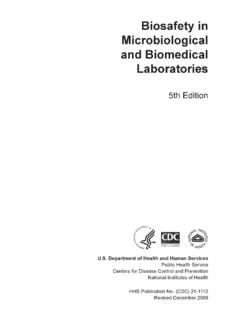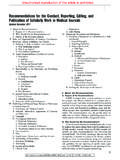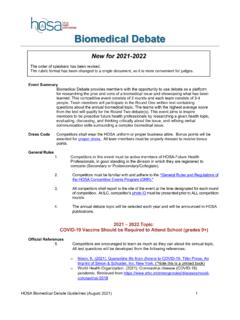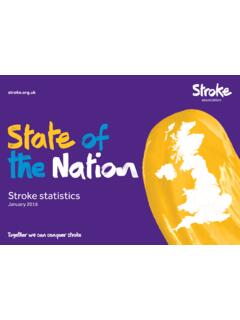Transcription of Principles of Biomedical Ethics
1 Chapter 2 Principles of Biomedical EthicsEthics and equity and the Principles of justice do not change with the calendar. D. H. LawrenceJustice consists not in being neutral between right and wrong, but in finding out the right andupholding it, wherever found, against the wrong. Theodore RooseveltChapter Learning ObjectivesAt the conclusion of this chapter the reader will be able to:1. Understand the relationships among moral value judgments, moral rules orideals, the Principles of Biomedical Ethics , and ethical theory2. List and explain the Principles of Biomedical ethics3. List and recognize the requirements for autonomous choice4. Define competencyanddecisional capacity5. Recognize and distinguish the various types of controlling influences thatundermine voluntariness6.
2 Recognize and distinguish nonmaleficence and beneficence7. Explain the rule of the double effect and recognize instances in which it doesand does not apply8. Recognize and distinguish specific and general beneficence9. Recognize situations in which beneficence is obligatory as opposed to ideal10. Define paternalismand distinguish between weak (soft) and strong (hard)paternalism11. Recognize instances in which strong (hard) paternalism might be justified12. State the formal principle of justice13. List several material Principles of justice14. Explain how utilitarian, egalitarian, and libertarian views of justice differIn the following excerpt, Joan Gibson compares Ethics to science in a way that is helpfulto us here and, in the process, provides a framework for the topics discussed in Section Iof this 1/21/09 1:56 PM Page 39 Jones and Bartlett Publishers, LLC.
3 NOT FOR SALE OR Chapter 2 Principles of Biomedical Ethics [A] comparison between the giving of good reasons in science, which is called explanation, and the giving of good reasons in Ethics , which is called moraljustification, reveals striking procedural similarities bordering on the question Why? [in science] .. is known as explanation: theaccounting for observed phenomena at levels of increased abstraction, general-ization, and simplification. Moving [in the opposite direction], once the Why? sare answered, generates the power of prediction about future similar observationsand so it is with giving good reasons for individual moral judgments.
4 Answering the Why? moving up the [ Ethics pyramid] is known as moral justi-fication. Moving down the [ Ethics pyramid], once the Why? s are answered,yields decisions about similar, future moral value judgments that must be Why? .. requires that reasons be elucidated and organized. Truthin science as well as in Ethics derives not so much from discovering isolated, once-and-for-all answers, but rather from continually articulating, evaluating andrevising the reasons one gives for the continually modified propositions oneasserts and the consistently reevaluated judgments one makes. Extrapolating intothe future (.. making [moral] decisions) is only as sound as the integrity of prior.
5 Moral 1 discussed the apex, as it were, of the metaphorical Ethics pyramid ethicaltheory. As we move down that pyramid, we will discuss Ethics in an increasingly concreteor specific way first at the level of moral Principles (the focus of this chapter), then at thelevel of moral rules (the focus of Chapter 3), and finally at the level of moral decisions inindividual cases (the focus of Chapter 4).Different people think about or analyze problems in bioethics in different ways. Somemay prefer to think through these problems in terms of the Principles of biomedicalethics; others prefer the moral rules based account of morality of Bernard Gert and asso-ciates (see Chapter 3); still others prefer the approach of casuistry (see Chapter 4).
6 One ofour purposes in this text, and in this section in particular, is to expose the reader to thesevarious , Principles , Rules, and Moral DecisionsThe focus of this chapter is on the Principles of Biomedical Ethics , or principlism. Beforeembarking on a discussion of the Principles themselves, let s consider the following question: What are moral Principles ? How do they relate to moral theory, moral rules, and moral decisions?A principlemay be defined as a basic truth or a generallaw or doctrine that is used asa basis of reasoning or a guide to actionor behavior. 2 Principles , like rules, are action guides,although, as the earlier excerpt should make clear, the guidance they provide is 1/21/09 1:56 PM Page 40 Jones and Bartlett Publishers, LLC.
7 NOT FOR SALE OR Belmont Report 41abstract or general than that provided by rules. Gert and colleagues have written that Principles really are action guides that summarize and encapsulate a whole [moral] theoryand thus, in a shorthand manner, assist a moral agent in making a moral decision. 3 Thus,deciding which moral principle (or Principles ) to invoke as an action guide will dependon the moral theory or theories to which one distinction between Principles and rules can perhaps further be illustrated throughthe use of an example drawn from the literature on the philosophy of law. Consider theproblem posed by a court s decision to deviate from precedent5 that is, to overrule itsown prior decisions.
8 Consider, for example, the important role that the Roe v. Wade6deci-sion has played in American jurisprudence and politics since 1973. Should the SupremeCourt reverse itself and overturn Roe v. Wade? If it did so, what would that say about thelawfulness of the original 1973 decision? Of the subsequent decision? The reluctance ofthe Court to reverse itself, and the reasons for that reluctance, were evident in the openinglines of the Court s opinion in Planned Parenthood of Southeastern Pennsylvania v. Casey,7acase in which it was thought that the Court might (though it did not) overrule Roe v. Wade: Liberty finds no refuge in a jurisprudence of considering.. the rule ofstare decisis [stare decisis means to abide by, or adhere to, decided cases ],5(p978)we are led toconclude this: The essential holding of Roe v.
9 Wadeshould be retained and once again reaffirmed. 8 There may be another way to look at the situation. Does a court that alters the law nec-essarily have to go outside the law to do so?Is it possible to argue that courts may alterthe law while still being boundby thelaw?..Ronald Dworkin has developed a theory which seems to explain how thatmight be argues that law does not consist solely of rulesdeliberately established in precedents and statutes. In his view, law also includesgeneral Principles which are implicit within the established black-letter provi-sions. Judges have the task of constructing a coherent moral theory that providesan appropriate abstract justification for the established rules and may interpret and modify established rules in a way that brings them moreclosely into line with the overarching abstract justification.
10 Thus, even whenjudges modifyestablished legal rules they are doing so in the application of deeperlegal Belmont Report The Principles [of Biomedical Ethics ] emerged from the work of the National Commis-sion for the Protection of Human Subjects of Biomedical and Behavioral Research, 3(p73)which was created by an act of Congress in 1974. The commission was charged with iden-tify[ing] the basic ethical Principles that should underlie the conduct of Biomedical andbehavioral research involving human subjects and .. develop[ing] guidelines 1/21/09 1:56 PM Page 41 Jones and Bartlett Publishers, LLC. NOT FOR SALE OR Chapter 2 Principles of Biomedical Ethicsshould be followed to assure that such research is conducted in accordance with thoseprinciples.


